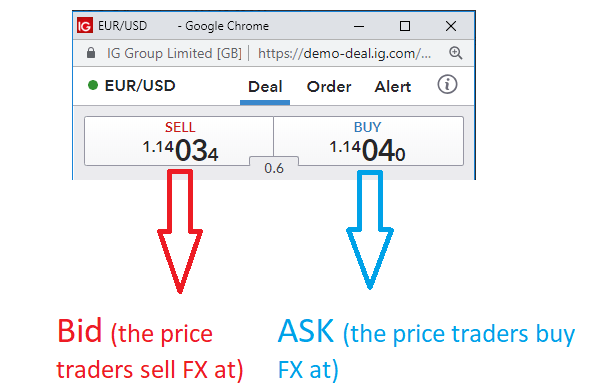In the dynamic realm of foreign exchange (forex) trading, the bid price and ask price dance hand-in-hand, representing the two sides of every currency transaction. Understanding these prices is paramount for any trader, as they form the foundation for calculating profits and minimizing losses. In this comprehensive guide, we will delve into the intricacies of bid and ask prices, exploring their significance, how they are determined, and their impact on your forex trading strategies.

Image: www.dailyfx.com
What are Bid and Ask Prices?
The bid price, also known as the ‘sell’ price, is the price at which a market participant is willing to buy a particular currency pair. On the other hand, the ask price, or ‘buy’ price, reflects the price at which a seller is willing to sell the currency pair. The difference between these two prices, known as the spread, represents the broker’s or market maker’s commission for facilitating the transaction.
The Significance of Bid and Ask Prices
The relationship between bid and ask prices is crucial for understanding the trading process. When you place a buy order, you are essentially agreeing to purchase the currency pair at the ask price. Conversely, if you place a sell order, you are willing to dispose of the currency pair at the bid price. The spread ensures that there is always a profit margin for the broker, while also dictating trading costs for the participant.
Factors Determining Bid and Ask Prices
Various factors influence the bid and ask prices in the forex market. These include:
- Supply and Demand: As with any other market, bid and ask prices are influenced by supply and demand dynamics. When there are more buyers than sellers, the ask price increases. Conversely, if more sellers are present, the bid price decreases.
- Economic News and Events: News and events with economic implications, such as interest rate announcements or geopolitical developments, can cause significant fluctuations in bid and ask prices.
- Order Flow: The volume and direction of orders being placed in the market can impact prices. A large number of buy orders can lead to an increase in the ask price, while a surplus of sell orders can push down the bid price.
- Brokerage Spreads: Different brokers offer varying spreads on currency pairs. The spread is typically determined by the broker’s trading costs, liquidity, and market position.

Image: dailypriceaction.com
Implications for Forex Trading Strategies
Understanding bid and ask prices is essential for developing effective forex trading strategies. By considering the following, you can enhance your trading decisions:
- Trade Execution: When placing a trade, consider the impact of the spread. Look for brokers with narrow spreads to reduce trading costs.
- Order Timing: High-volatility periods can result in wider spreads. Placing orders during low-volatility periods can minimize spread-related losses.
- Profit Targets: Set realistic profit targets based on the spread. Always factor in the cost of the spread when determining your desired profit.
- Risk Management: Spread fluctuations can affect your risk exposure. Adjust your stop-loss and take-profit levels accordingly based on the prevailing spread.
Bid Price And Ask Price In Forex
Conclusion
Navigating the bid price and ask price is crucial for success in forex trading. By understanding these prices, their determinants, and their implications for trading strategies, you can position yourself for profitable opportunities in the global currency market. Remember to conduct thorough research, choose a reliable broker, and always consider the impact of spreads on your trading decisions. By mastering the dynamics of bid and ask prices, you can unlock the full potential of forex trading.






